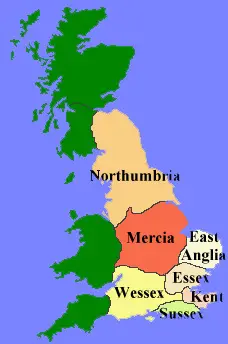|
The Anglo-Saxon Heptarchy
The Roman Empire had invaded England three times in the 1st Century B.C. and the 1st Century A.D. Julius Caesar led two of those invasions but took his troops home both times. Claudius sent a much larger force and began what eventually became a transition from Britain into Roman Britain. Roman troops left Britain for good in the early 5th Century. Before they left, though, their numbers included soldiers from various part of the Empire and from non-Empire lands as well. Of relevance to the story of the advancement of settlements in Britain was the fact that some Roman soldiers hailing from Germany were in Britain as early as the 4th Century. In fact, Rome had built a series of forts along the southeastern edge of the Island, to protect against seaborne invasions from Germany. These became known as the Saxon Shore forts.
The Jutes settled in Kent. Other Germanic areas were called East Anglia, Essex, Mercia, Northumbria, Sussex, and Wessex. This was known as the Heptarchy. The Germanic peoples continued to press onward in their occupation of British lands; they also began to fight among themselves. Part 2: Kent and Mercia |
|
Social Studies for Kids
copyright 2002–2024
David White



 When Rome left for good, in 410, Roman soldiers would have left through Kent. Some Roman soldiers stayed behind, and some of these were from Germanic areas of Europe. Filling the power vacuum in post-Roman Britain was a high-king named Vortigern, who, in desperation for support against an invasion from Scotland, called on Germanic peoples to serve as mercenaries. An entry in the
When Rome left for good, in 410, Roman soldiers would have left through Kent. Some Roman soldiers stayed behind, and some of these were from Germanic areas of Europe. Filling the power vacuum in post-Roman Britain was a high-king named Vortigern, who, in desperation for support against an invasion from Scotland, called on Germanic peoples to serve as mercenaries. An entry in the 
